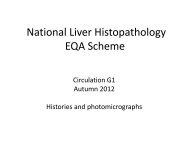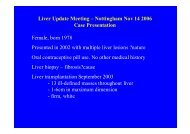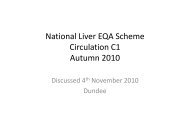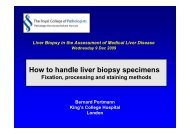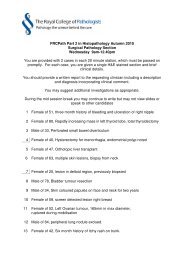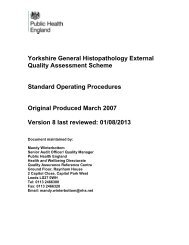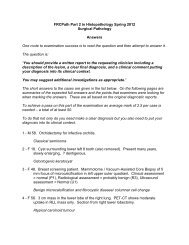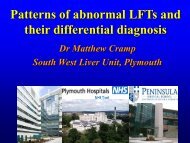Fatty liver disease - Virtual Pathology at the University of Leeds
Fatty liver disease - Virtual Pathology at the University of Leeds
Fatty liver disease - Virtual Pathology at the University of Leeds
- No tags were found...
You also want an ePaper? Increase the reach of your titles
YUMPU automatically turns print PDFs into web optimized ePapers that Google loves.
Basic p<strong>at</strong>terns <strong>of</strong> <strong>liver</strong> damage – wh<strong>at</strong><br />
inform<strong>at</strong>ion can a <strong>liver</strong> biopsy provide<br />
and wh<strong>at</strong> clinical inform<strong>at</strong>ion does <strong>the</strong><br />
p<strong>at</strong>hologist need?<br />
Rob Goldin<br />
r.goldin@imperial.ac.uk
Wh<strong>at</strong> inform<strong>at</strong>ion can a <strong>liver</strong><br />
biopsy provide?
Donald Rumsfeld’s guide to knowledge<br />
(and to <strong>liver</strong> biopsy requests)<br />
• “… <strong>the</strong>re are known knowns; <strong>the</strong>re are things<br />
we know we know.<br />
• We also know <strong>the</strong>re are known unknowns;<br />
th<strong>at</strong> is to say we know <strong>the</strong>re are some things<br />
we do not know.<br />
• But <strong>the</strong>re are also unknown unknowns - <strong>the</strong><br />
ones we don't know we don't know."
“….<strong>the</strong>re are known knowns; <strong>the</strong>re<br />
are things we know we know.”
The clinician knows <strong>the</strong> diagnosis but<br />
wants to know something more<br />
Examples<br />
1. Chronic viral hep<strong>at</strong>itis<br />
2. <strong>F<strong>at</strong>ty</strong> <strong>liver</strong> <strong>disease</strong><br />
3. Iron overload
Chronic viral hep<strong>at</strong>itis<br />
• Assess <strong>disease</strong> severity:<br />
Grade (necro-inflamm<strong>at</strong>ion) and<br />
Stage (fibrosis)<br />
? Score (using modified Histological Activity<br />
Index / METAVIR)<br />
• Assess <strong>disease</strong> progression or response to<br />
tre<strong>at</strong>ment<br />
Modern <strong>P<strong>at</strong>hology</strong> 2007; 20: S3
Chronic viral hep<strong>at</strong>itis<br />
• Hep<strong>at</strong>itis rel<strong>at</strong>ed changes<br />
e.g. Large cell change, HDV<br />
• Something else going on?<br />
Modern <strong>P<strong>at</strong>hology</strong> 2007; 20: S3
Large cell change<br />
• A focus <strong>of</strong> large cell change is defined as:<br />
a group <strong>of</strong> hep<strong>at</strong>ocytes with nuclear and<br />
cellular enlargement, normal N:C, nuclear<br />
pleomorphism, multinucle<strong>at</strong>ion, nuclear<br />
pseudoinclusions and prominent nucleoli<br />
Liver Intern<strong>at</strong>ional 2005; 25: 16
Large cell change<br />
• A marker for developing HCC (reactive) r<strong>at</strong>her<br />
than premalignant condition (dysplastic)<br />
Hep<strong>at</strong>ology 1996; 23: 1112<br />
but …<br />
Hep<strong>at</strong>ology 2009; 50: 752
Large cell change (or is it dysplasia?)
HDV
Drug reaction
? Something else going on<br />
• <strong>F<strong>at</strong>ty</strong> <strong>liver</strong> <strong>disease</strong><br />
ste<strong>at</strong>ohep<strong>at</strong>itis in 5% <strong>of</strong> <strong>liver</strong> biopsies <strong>of</strong><br />
p<strong>at</strong>ients with chronic <strong>liver</strong> <strong>disease</strong><br />
Mod P<strong>at</strong>hol 2003; 16: 49<br />
• Iron overload<br />
In p<strong>at</strong>ients with HCV: stainable iron was<br />
detected in 16%, grade 2 and 3 iron in 7%.<br />
J Gastroenterol Hep<strong>at</strong>ol 2005; 20: 243
<strong>F<strong>at</strong>ty</strong> change associ<strong>at</strong>ed with<br />
HCV genotype 3
<strong>F<strong>at</strong>ty</strong> <strong>liver</strong> <strong>disease</strong><br />
• How severe is <strong>the</strong> f<strong>at</strong>ty change?<br />
• Is <strong>the</strong>re a f<strong>at</strong>ty <strong>liver</strong> hep<strong>at</strong>itis?
<strong>F<strong>at</strong>ty</strong> <strong>liver</strong> <strong>disease</strong><br />
• How severe is <strong>the</strong> f<strong>at</strong>ty change?<br />
Ignore less than 5%<br />
Mild 5-33%<br />
Moder<strong>at</strong>e 34-66%<br />
Severe 67-100%<br />
Hep<strong>at</strong>ology 2005; 41: 1313
<strong>F<strong>at</strong>ty</strong> <strong>liver</strong> <strong>disease</strong><br />
• Is <strong>the</strong>re a f<strong>at</strong>ty <strong>liver</strong> hep<strong>at</strong>itis?<br />
Ballooning and inflamm<strong>at</strong>ion<br />
• Is <strong>the</strong>re fibrosis?<br />
Clin Liver Dis 2009; 13: 533
<strong>F<strong>at</strong>ty</strong> change: Portal tract fibrosis
Histology <strong>of</strong> NASH<br />
NAFLD Activity Score is <strong>the</strong> unweighted sum <strong>of</strong>:<br />
1. ste<strong>at</strong>osis (0-3)<br />
2. hep<strong>at</strong>ocellular ballooning (0-2)<br />
3. lobular inflamm<strong>at</strong>ion (0-2)<br />
NAS>5 “NASH”<br />
NAS
Iron overload<br />
• Wh<strong>at</strong> is <strong>the</strong> p<strong>at</strong>tern if iron overload?<br />
• Grade <strong>the</strong> degree <strong>of</strong> iron overload<br />
• Assess fibrosis<br />
• ? Send tissue for biochemical iron<br />
measurement<br />
American Journal <strong>of</strong> Gastroenterology 2000;<br />
95: 1788
Wh<strong>at</strong> is <strong>the</strong> p<strong>at</strong>tern <strong>of</strong> iron<br />
overload?<br />
• Parenchymal<br />
• Macrophage
Parenchymal iron:<br />
Simple Scoring System<br />
Grade Histological Fe<strong>at</strong>ures<br />
0 No iron present<br />
1 Iron seen in periportal hep<strong>at</strong>ocytes<br />
2 Iron seen in periportal and midzonal<br />
hep<strong>at</strong>ocytes<br />
3 Iron seen in all zones with a gradient from<br />
<strong>the</strong> periportal to <strong>the</strong> perivenular zones<br />
4 Iron seen in all zones with no gradient<br />
from <strong>the</strong> periportal to <strong>the</strong> perivenular<br />
zones
“We also know <strong>the</strong>re are known<br />
unknowns; th<strong>at</strong> is to say we know<br />
<strong>the</strong>re are some things we do not<br />
know.”
Clinician suspects <strong>the</strong> diagnosis<br />
and wants your help<br />
Examples:<br />
1. Autoimmune hep<strong>at</strong>itis<br />
2. Drug reaction<br />
3. Wilson’s <strong>disease</strong>
Autoimmune hep<strong>at</strong>itis<br />
• Help in making <strong>the</strong> diagnosis<br />
• Help in assessing <strong>the</strong> response to tre<strong>at</strong>ment
Revised AIH scoring system<br />
proposed by <strong>the</strong> IAIHG<br />
• Liver histology<br />
Interface hep<strong>at</strong>itis +3<br />
Lymphoplasmacytic infiltr<strong>at</strong>e +1<br />
Rosetting <strong>of</strong> <strong>liver</strong> cells +1<br />
None <strong>of</strong> <strong>the</strong> above -5<br />
Biliary changes -3<br />
O<strong>the</strong>r changes -3
Simplified histological criteria for<br />
• “Typical”<br />
1. Interface hep<strong>at</strong>itis<br />
<strong>the</strong> diagnosis <strong>of</strong> AIH<br />
2. lymphocytic / lymphoplasmacytic infiltr<strong>at</strong>es in portal tracts<br />
and extending into <strong>the</strong> lobule<br />
3. rosetting <strong>of</strong> <strong>liver</strong> cells<br />
• “Comp<strong>at</strong>ible" a chronic hep<strong>at</strong>itis with lymphocytic<br />
infiltr<strong>at</strong>ion without all <strong>the</strong> above fe<strong>at</strong>ures<br />
• “Atypical" for AIH when showing signs <strong>of</strong> ano<strong>the</strong>r diagnosis.<br />
Am J Gastroenterol advance online public<strong>at</strong>ion<br />
3 November 2009; doi: 10.1038/ajg.2009.616
Autoimmune Hep<strong>at</strong>itis
Autoimmune Hep<strong>at</strong>itis
AIH: Tre<strong>at</strong>ment failure<br />
• Its occurrence justifies clinical reassessment to exclude<br />
noncompliance with <strong>the</strong>rapy, alcohol consumption, or drug<br />
toxicity.<br />
• Labor<strong>at</strong>ory studies to exclude a superimposed viral infection<br />
or a transition st<strong>at</strong>e to PBC or PSC, and <strong>liver</strong> tissue is<br />
examined to reconfirm <strong>the</strong> original diagnosis and to assess<br />
altern<strong>at</strong>ive possibilities, including f<strong>at</strong>ty infiltr<strong>at</strong>ion, PBC, or<br />
PSC.<br />
Hep<strong>at</strong>ology 2007; 46: 1138
• Remission:<br />
Response to Tre<strong>at</strong>ment in<br />
Autoimmune Hep<strong>at</strong>itis<br />
Normal or minimal histological activity<br />
• Incomplete response<br />
Improved but more than minimal histological<br />
activity<br />
• Failure<br />
Worsening histological activity
Drug reaction
Drug reaction<br />
• “Any kind <strong>of</strong> <strong>liver</strong> <strong>disease</strong> can be caused by a<br />
drug”<br />
• Histological fe<strong>at</strong>ures suggesting a drug<br />
reaction:<br />
Eosinophils, plasma cells, granulomas, sharply<br />
demarc<strong>at</strong>ed necrosis, cholest<strong>at</strong>ic hep<strong>at</strong>itis<br />
J Clin P<strong>at</strong>hol 2009; 62:481
Drug reaction
Drug reaction
Wilson’s <strong>disease</strong>
Wilson’s <strong>disease</strong>
Wilson’s Disease<br />
Demonstr<strong>at</strong>ion <strong>of</strong> copper<br />
1. stains for Cu associ<strong>at</strong>ed protein: orcein<br />
2. stains for Cu: rhodamine, rubeanic acid<br />
but:<br />
1. ease <strong>of</strong> demonstr<strong>at</strong>ing copper varies with<br />
<strong>the</strong> stage <strong>of</strong> <strong>the</strong> <strong>disease</strong><br />
2. can be due to chronic cholest<strong>at</strong>ic <strong>liver</strong><br />
<strong>disease</strong>s
Wilson's <strong>disease</strong>:<br />
Diagnostic Criteria<br />
• Low serum caeruloplasmin levels<br />
• Kayser - Fleischer rings<br />
• High <strong>liver</strong> Cu levels > 250 micrograms/g dry weight<br />
• High 24 hr urinary copper levels<br />
• Radioisotope copper studies which assesses <strong>the</strong><br />
ability to incorpor<strong>at</strong>e copper into caeruloplasmin<br />
N<strong>at</strong>ure Clinical Practice Neurology 2006: 2;482-493
“But <strong>the</strong>re are also unknown<br />
unknowns -- <strong>the</strong> ones we don't<br />
know we don't know."
The clinician doesn't even suspect <strong>the</strong><br />
diagnosis<br />
• Examples:<br />
1. Granulomas<br />
2. Disappearing bile ducts
Granulomas<br />
• 2-10% <strong>of</strong> all <strong>liver</strong> biopsies<br />
• 1/3 have no known cause<br />
• Classific<strong>at</strong>ion<br />
Adv An<strong>at</strong> P<strong>at</strong>hol 2008; 15: 309
You can see <strong>the</strong> cause<br />
• Mycobacterial infection<br />
• Schistosomiasis
You can have an educ<strong>at</strong>ed guess<br />
• Sarcoid<br />
• PBC
Clinician (and P<strong>at</strong>hologist) does not<br />
suspect <strong>the</strong> diagnosis<br />
• Example:<br />
Disappearing bile ducts
Causes <strong>of</strong> Disappearing bile ducts<br />
• PBC (and its variants)<br />
• PSC<br />
• Drugs and Toxins<br />
• Chronic transplant rejection<br />
• Graft Vs. Host<br />
• Hodgkin’s Disease, Histiocytosis X<br />
• Sarcoid<br />
• Paucity <strong>of</strong> interlobular bile ducts<br />
• Idiop<strong>at</strong>hic
Biliary tract <strong>disease</strong>
Biliary tract <strong>disease</strong>: Orcein stain
Biliary tract <strong>disease</strong>: CK7
Wh<strong>at</strong> clinical inform<strong>at</strong>ion does <strong>the</strong><br />
p<strong>at</strong>hologist need?
Wh<strong>at</strong> clinical inform<strong>at</strong>ion does <strong>the</strong><br />
p<strong>at</strong>hologist need?<br />
• A decent clinical history!
Clinical inform<strong>at</strong>ion<br />
• Look <strong>at</strong> <strong>the</strong> biopsy and write <strong>the</strong> description<br />
without knowing any clinical inform<strong>at</strong>ion<br />
• Only write <strong>the</strong> conclusion when you have <strong>the</strong><br />
inform<strong>at</strong>ion
Biopsy Diagnosis <strong>of</strong> Liver Disease<br />
Daniel Snover<br />
• Dedic<strong>at</strong>ed to<br />
“<strong>the</strong> multitude <strong>of</strong> p<strong>at</strong>ients with abnormal<br />
LFTs”
Proposed classific<strong>at</strong>ion <strong>of</strong> <strong>liver</strong><br />
request forms
Inadequ<strong>at</strong>e <strong>liver</strong><br />
request form
Misleading <strong>liver</strong> request form<br />
• “HCV Cirrhosis”
“HCV Cirrhosis”
Surreal <strong>liver</strong> request form<br />
“Nodule left knee, 4cms, mobile<br />
? Ganglion”
Adequ<strong>at</strong>e <strong>liver</strong> request form
Honest request form



